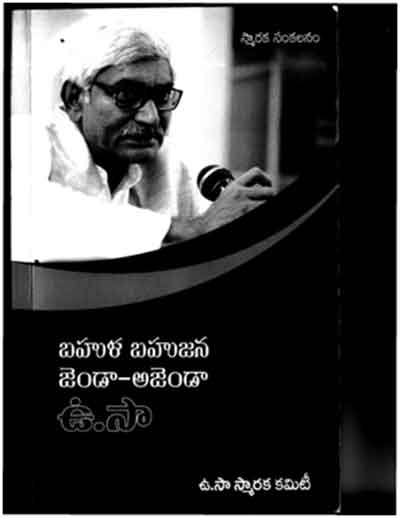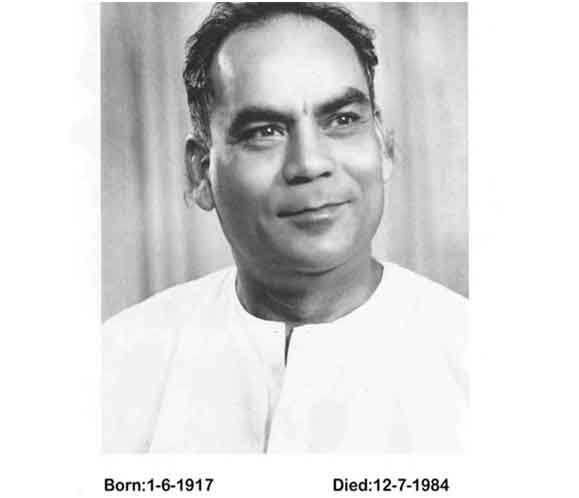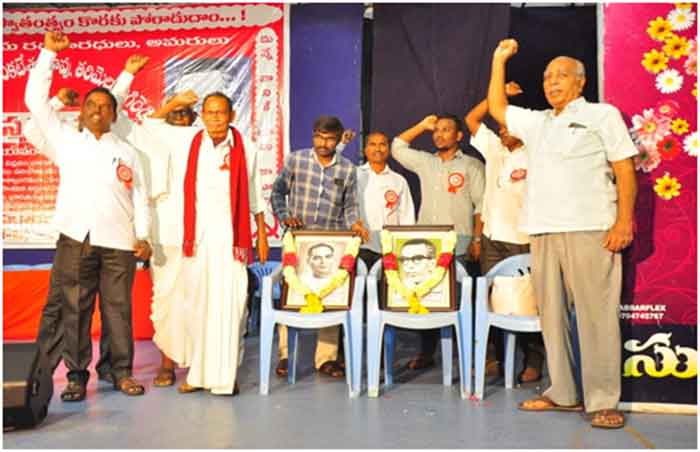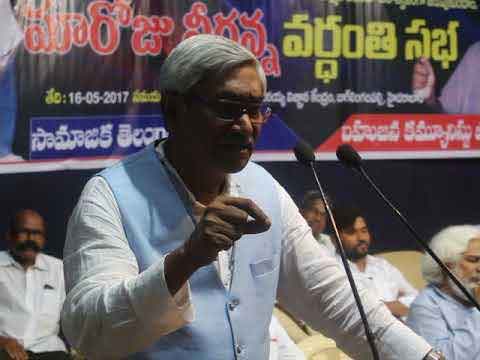
“Usaa, The Greatest Revolutionary Barber After Upali, Died of COVID-19”, is the title of an obituary by Kancha Ilaiah Shepherd, (countercurrents.org, August 4,2020, “a long-time associate of Usaa Barber, Political Theorist and Author”.
It begins thus : “Usaa Barber (Uppumavuluri Sambashivarao) (1951-2020)- a well-known social reformer, anti-caste ideologue and anti-brahminism fighter succumbed to COVID-19 on 25th July 2020.”
Then it goes on: ““In the 1960s, a barber going to school in that region was rarest of rare thing…. A barber had no right to enter the temple along with Dalits…”
Ilaiah then discovers : “ Usaa stood by Nagireddy to finish DVRao’s revolutionary Brahminism. But Nagireddy never saw brahminism in communism and died unsuccessful.”
He goes into food habits of individuals … goes into Usaa’s family life with his wife (born Brahmin) and makes statements like:
“Usaa was married to a Brahmin woman within the party. The DVR’s camp tried to set his wife (Padma) against him. But he could take her with him…
“Like Gandhi, DVR also thought that all Indians should become vegetarian only to die after his communism comes to go to Hindu swarga. But they managed with great difficulty to be under one roof till their death as Padma died in 2015 in his lap.”
Towards the end he says :
“In the literary and cultural field in Telugu states P.Varavara Rao led that strategy of Brahmin control… Varavara Rao with his friends did that quite consistently…”
And concludes thus :
“However, he made it difficult for the communists to continue their long-time caste-blind approach and continue the brahminism in future–a life that never rested till he breathed his last.”
*** ***
Normally an obituary does not become so much of a controversy that deserves to be commented upon and refuted. But this one by Ilaiah must be an exception for many many reasons.
This comment or criticism, it needs to be stated at the outset, is not at all meant to be an appraisal of Usaa and his work. Much has been said and written about him in Telugu. But there is none that merited such a refutation as this. This comment has a positive purpose to convey how not to write an obituary – dragging even a dead person into controversy.
This obituary has many many things Usaa would never have agreed or allowed to pass without comment; his writings bear out this fact. He died prematurely of covid-19. He should not be killed a second time by the dagger of falsehood about his life, personal and public, and by misrepresentation of his work. So this is the best way to remember Usaa, a sincere and dedicated communist revolutionary who strayed from that path and turned into a reformist, by one who knew and read him for long even if not in agreement on many things of his later phase of life.
This comment is based on authentic and indisputable facts, verified with his work and his close associates for decades.
*** ***
It needs to be critically examined and rejected for all of its follies.
Normally an obituary does not become so much of a controversy that deserves to be commented upon and refuted. But this one by Ilaiah must be an exception for many many reasons: It is full of falsehood, inventions, and venom; totally inobjective in its observations about the socio-historical context of the subject; being written by a Professor of social sciences, it has the danger of its readers being horribly misled.
If this obituary were in Telugu (both Usaa and Ilaiah are well known to Telugu readers and people), very few would have taken it seriously; like this writer, they know both for more than three decades so well that it would not be taken as a piece of serious writing. And indeed that was what was told by close friends, and erstwhile associates of both Usaa and Ilaiah about this write-up.
There were many who said and wrote about Usaa after his death, but this piece is unique that needs to be refuted. And being published in countercurrents.org, a reputed English journal and being a reliable resource for many, it has the risk of being believed to be a bit of serious and true writing which is not the case.
This refutation is a must even for the single reason of protecting the reputation and reliability of countercurrents.org , which this writer greatly regards. Being written by a well known retired Professor, the editor could not have imagined that this obituary is full of falsehood, irrespective of the viewpoint it takes. For all these reasons, it badly needs to be critically examined and to be rejected for all of its follies.
*** ***
It is ALL slander, pure and simple, a concoction.
What follows in this section is not a question of views or interpretations, but of facts known to people, more so Telugu-speaking. The obituary makes unseemly and patently false references to great communist revolutionaries respected by millions of Indian people, DV Rao and T.Nagi Reddy, whose birth centenaries were celebrated in 2017, and about whom this journal had published many authentic materials, including their views on caste and casteism, that were stated at length by 1970-71. Thus one can join issues with their views on caste, but obviously both were not “caste-blind” as alleged.
Ilaiah further wrote:
“DVR was treating a much better revolutionary leader, Tarimela Nagireddy, who is a Shudra and the author of a famous economic theory book ‘India Mortgaged’ as an unworthy leader. Usaa stood by Nagireddy to finish DVR’s revolutionary Brahminism. But Nagireddy never saw brahminism in communism and died unsuccessful.”
As a close friend, and an old team mate, of both Usaa and Ilaiah suggested, it is all a “creation” of the latter, who vainly seeks to besmirch the image of both DV and TN. It is slander, pure and simple, a concoction.
Ilaiah used such epithets as “DVR’s so-called Braminic-Marxist theory”, “revolutionary Brahminism”, “caste-blind communist brahminism” and “caste-blind approach”. “But Nagireddy never saw brahminism in communism”. They are inventions of Ilaiah, patently false, people know it through their writings as well as practice. Readers of coutercurrents.org know about them through authentic materials backed by documentary evidence. Both TN and DV were leaders who were very close to rural life, both were popular leaders who were elected to Loksabha (1957-62). Plus TN was MLA three times. They were never “caste blind”, they could not be, being so close to people. On the other hand, DV Rao had discussed not only caste, but also casteism in communist parties also.
DV’s views on caste, declared in a Court, as early as 1970 period are available here :
https://countercurrents.org/2020/07/comrade-dv-rao-unique-role-in-indian-communist-movement/
TN’s views on caste, declared in a Court, as early as 1970 period are available here:
https://countercurrents.org/2017/02/remembering-t-nagi-reddy/
Their mutual relations, as also DV’s views on TN, can also be seen in so many articles in countercurrents.org, and in the “famous economic theory book India Mortgaged ” cited by Ilaiah himself. DV Rao’s views and practice too were also available in the book shelf of Ilaiah, people who visited him tell us. It was therefore not ignorance, but something else which leads him to wallow in slanderous writing, damaging to Usaa also.
TN was an illustrious comrade-in-arms of DV Rao for decades, and died in 1976, while DV Rao died in 1984 (both were born in 1917, both died while leading UG lives). TN was always in the central leadership, and both are always and inseparably referred to as founder leaders of APCCR and later UCCRI-ML, and volumes are published about this, including several times in countercurrents.org.
India Mortgaged by TN was first published in 1978 under the personal guidance of DV Rao (then in UG) with DV’s detailed Foreword of 18 pages, signed by DV with the pen name Naveen Chandra. In later editions, DV’s name is mentioned in brackets after the pen name. The Foreword includes a glorious life-sketch of TN by DV and a great appreciation of TN’s contributions:
“ Hence we are firmly in a position to say that the analysis of Indian situation he (TN) has made and the conclusions he has drawn are valid even today. They will be guidelines for the Marxist-Leninists and democratic forces for further study and future course of action. The communist revolutionaries all over India are indebted to him, for his unique contribution which enrich their Marxist-Leninist understanding of Indian situation as it exists today.” .
He concluded the Foreword thus: “ (TN) he sacrificed what all he had for Indian revolution. He is the product of the best in Indian communist revolutionary (CR) movement. It is a proud privilege of CRs to have him as their leader.”
DV Rao’s writings on TN and his work were published, and reprinted,also as separate booklets. TN had earlier reciprocated similar appraisal about DV Rao.
Ilaiah’s words in this regard are thus utterly false and slanderous, puerile inventions and need to be rejected with all the contempt they deserve.
TN’s book with this Foreword was published several times in English and Telugu, and also in other languages including Hindi and Tamil. The book must have been in Ilaiah’s shelf but he is one who can write what he wrote (“DVR treating…TN as an unworthy leader”), with least regard for truth.
*** ***
Slander in an obituary : Ilaiah alone indulged in it
There were many obituaries on Usaa. There was a longish pamphlet (4 pages of A-4 size) on him by his close associates in the name of AIKANPS. There were online meetings among circles close to him: None mentions DV Rao, even indirectly. There was also some controversy published after Usaa’s death in relation to the group that had expelled Usaa. DV’s name does not figure anywhere in it, obviously because Usaa had nothing to do with him after 1980-81.
Slander in an obituary; that was unique contribution by Ilaiah, all of it based on utter falsehood, as we shall further see below:
Usaa had his own views on caste-class question. But there is nothing, in the last 30 plus years, not even one sentence, in Usaa’s writings, for instance, to say “Usaa stood by Nagireddy to finish DVR’s revolutionary Brahminism.”
See bare facts, including dates :
TN died in 1976, and DV Rao in 1984. There were no differences between them, more so on caste question. Ilaiah himself says : “He was expelled from the Nagireddy group, few others along with me in 1986 on the same question of caste and Ambedkarism,” wrote Ilaiah. The “Nagireddy group” was a break away faction claiming TN’s name that was formed five years after TN died in 1976. He was expelled in 1986 by that group. And that had nothing to do with the organization led by DV Rao, simply because Usaa was not in it after 1980-81; caste and Ambedkarism were never raised by Usaa until after Karamchedu incident in 1985.
But still Ilaiah alone can write “Usaa stood by Nagireddy to finish DVR’s revolutionary Brahminism.” Whatever Usaa said or wrote was years after both TN and DV died. There were a few obituaries, but none mentioned DV. But Ilaiah does not bother about facts. On different questions he had to be saved from the wrath of the people, and that was widely published in the media. Kancha Ilaiah Shepherd is incorrigible, people exclaim. There is a Telugu usage, very popular in political circles : If you spit on the sun, that will only fall on you.” That is very apt for his comments on TN and DV.
*** ***
Caste blind ? Nay, blind casteism
Ilaiah, blind to well known facts, wrote :
“There was a Brahmin (pure vegetarian) leader called DV Rao, who was claiming all theoretical authority on Marx, Lenin and Mao as if they were like Vedavyasa. Their’s was a culture of read and recite among their families hence they would pick up quotations from Marx, Lenin and Mao’s writings and write funny documents and ask the Shudra/Dalit/Adivasi cadre to apply to them to the concrete conditions of India’s class system,as if there was no caste in India of their mind. What an understanding of concrete conditions of India!”
He brings in food habits of individuals including Usaa’s vegetarian wife, and later wrote of “caste trained food culture” etc., irrelevantly, again with no respect for facts. DV was not a vegetarian, he ate meat regularly; anybody who worked with him, or even hosted him, knows that. Ilaiah has no sense to check his facts, irresponsible. ( About her, we shall see later.)
Coming to more substantial issues, DV’s writings have very few quotations, and always they are linked with concrete Indian realities, which is known to any reader of DV.
DV was not one who saw Marx or anyone as Vedavyasa. He was a rare Indian communist leader who boldly wrote , “Theory of Infallibility is Wrong” which is the sub-title in an important article of 26-10 1980, written by DV Rao, published in English and Telugu several times (October and November Revolutions: Some problems facing international communist movement.). Definitely his was a not brahminical communism citing Marxist scriptures. Referring to a tendency in international and Indian communist movements, DV Rao ( he was a CC Member of undivided CPI by 1950) wrote :
“Therefore, the experience has proved that even the greatest leaders of the calibre of Stalin and Mao are not infallible. So also the parties in general. This is a valuable lesson that we have learnt and a harsh lesson at that.”
Elsewhere he explained how Marx, Engels, Lenin too admitted of their mistakes and made self-criticism. At a time when Mao and CPC were at the peak of their popularity, DV an ardent supporter of them, dared to take an independent line, and expressed the same.
*** *** How can anyone say DV was caste blind?
DV Rao saw and wrote on caste, dealt with its dynamics, caste in its motion, social as well as political casteism. And he discussed, in a published interview 1984, casteism in communist movement.
(see Comrade DV Rao: Unique Role In Indian Communist Movement, in countercurrents.org, July 12, 2020)
https://countercurrents.org/2020/07/comrade-dv-rao-unique-role-in-indian-communist-movement/
He was not one, as alleged by Ilaiah, to “ask the Shudra/Dalit/Adivasi cadre” to study and apply. He travelled, met, and stayed in hundreds of villages directly with people for years. He spent around 17 years in underground activities and about 5 years in various jails. DV Rao’s magnum opus, The History of the People’s Armed Struggle of Telangana (1946-51) Volume-I, in Telugu, was published in 1988 July, four years after his death. (Royal Demy volume in Telugu of 420 plus 32 pages. Printed thrice.) That book also gives glimpses of his grass-roots work.
History Professor (Retired) Inukonda Tirumali (author of Against Dora ), for his doctoral work (Delhi University) had studied Telangana ( upto 1948 September Police Action) and DV Rao’s role extensively, and he was one of the very few who accessed police records of 1940-52 period, and found how DV Rao everywhere was very very personally active amidst people.
DV Rao: Unique Role (cited above) :
“As one who applied Marxism to India’s concrete conditions to develop a Program and Path for Indian Revolution, unlike various revisionists and trade unionists with their narrow experiences and outlook , he (DV) very much reckoned with the caste question on a larger canvas. His writings from 1940s reflect that.
“Based on his revolutionary mass work, as the movement spread from Jangaon taluq into a Nalgonda district-wide movement, DV Rao wrote and published detailed Field Reports, a trend-setter in that genre, as early as 1944-46. Heroic Struggles of People of Jangaon (taluq) 1944-45 (about 100 pages in print), Heroic Struggles of People of Nalgonda (district) 1946, and other Reports, like on Vetti/Begar(1946-47), (as many pages), are some examples.
“These Reports of 1940s contain specific and vivid reports of how rural poor of various castes were exploited; in Telangana’s feudalism , across the entire caste spectrum, top to bottom, they were exploited and oppressed by feudalism. Notably, he saw caste more deeply than with a reformist Gandhian approach. DV Rao saw caste and casteism are much more pernicious than untouchability, which is the most heinous explicit feature and forms.
“Heroic Struggles of People of Jangoan (1946), about 100 pages in print, which was banned by the Nizam a few months later, had a few explicit references to some dalit rural poor, among other castes, being exploited and helped out. It refers to a bitter armed clash (with native arms) with Nizam’s armed forces in Mallareddy gudem village, wherein five people were killed… DV specifically names, and salutes, three dalit women martyrs there : Guravamma, Tondamma, Ankalamma …DV wrote : they are Telangana’s Jhansis and Chand Bibis… along with one Appi Reddy and Mungi Veerayya, of yadav caste. (Jangoan, 1946)
“The samebook on Jangaon mentions cases from a few villages where ‘Harijans’, (dalits), got converted to Islam to escape vetti-begar etc…that was mostly before the AMS organized them…Ramavaram village of Kadaru Ramachandra Rao, a feudal Mali Patel; Mundrai is another such village. The report mentions conversions also by ‘other castemen’, ‘so as to contend feudals’.
It is notable that caste politics even of those days were discussed then :
Another contemporary Report of 1944 mentions how the Nizam administraton promoted conversions of ‘Harijans’ into Islam hoping it would strengthen pro-Nizam forces in the event of elections that were contemplated as part of reforms. It was a politically motivated attempt made after Congress elsewhere won in provincial polls after 1938.
He saw caste in its link with class and found that even the poor from among Brahmins, priests, vyshyas were being victimized including being forced to render vetti (begar, unpaid labor and services), And there were dalit elite who stood with the Nizam, and with reformism. Hence his views, very briefly stated here, are not academic; he adopted the method of seeking truth from facts; his observations are rooted in concrete reality. They merit and call for serious and deep study.
In his 1971 Court Statement also he names women, mentions dalit woman Nagamma was among those who led resistance and was killed while fighting.(p.52, PDR).
It is notable that DV discussed caste politics and caste theories, even if briefly, in his seminal work,PDR, ie., Court Statement, written, and read out in a special court, in 1971, including in a special section devoted on caste.Then he added a review, a Re-look, of caste system in his Foreword of 1981 May to PDR’s Second Reprint.
*** ***
He saw the close connection between the caste and class. In 1971 itself he wrote :
“In our countryside, the caste system is linked with landlordism. While the landlords belonged to certain castes, the overwhelming majority of poor peasants and the agricultural labourers belong to certain other castes. Thus the landlord domination turned into upper caste domination also. These landlords are able to prevent the middle and poor peasants and agricultural labourers from uniting with the same belonging to other castes, against themselves, ie., landlords. They are able to divide them. This is the case with all castes, wherein the mass of the people are under the influence of the upper strata of their own castes. The class of landlords is using the caste system for political purposes. They purchase the elders and the top strata of other castes…. (p.171-172. PDR, 1971.)
His was not a doctrinaire and static view. He also discussed caste dynamics influenced and engineered by ruling classes.
It is not “caste blind communism”so far as TN and DV are concerned, as borne out by their published (1970) writings, also in countercurrents.org. Rather, it is a case of blind casteism of Ilaiah that led him to convert and reduce Usaa, into “Usaa Barber.” More of it later.
And Ilaiah makes similar reckless references to Varavara Rao, reputed revolutionary writer who was not convicted for any crime, at a time he is languishing in jail despite his old age (80 plus) and sickness. For instance, he wrote:
“In the literary and cultural field in Telugu states P.Varavara Rao (VV) led that strategy of Brahmin control…Even if others–Shudras/Dalits/Adivasis come into that field, marginalizing their written word or making it invisible has been a historical strategy. Varavara Rao with his friends did that quite consistently.”
The whole world knows, and acknowledged by all in writings, including by VV, that dalit-born revolutionary poet KG Satya Murthy (Siva Sagar was one of his pen names) was a key leader who laid the foundations of VIRASAM, the revolutionary writers organization in 1970 period. Many, nay most of its General Secretaries, the key office-bearer in communist organizations, were “others” including dalit-born Kalyan Rao, like KVR, Nikhileshwar, T.Madhusudna Rao, Cherabanda Raju. Each of them were accomplished, and well published, revolutionary writers too well known to be “marginalzed”, by anyone. Ilaiah alone can write such things, with not an iota of truth. In fact, Satya Murthy, a Polit Bureau Member, was the all India General Secretary of CPI-ML PWG when Kondapalli was arrested. He was much more than a writers’ leader. Very few knew or cared to know that he was dalit-born, until decades later, when he himself revealed it as he shifted his politics.
*** ***
Relations between Usaa and his wife are distorted and vulgarized
Ilaiah did not spare Usaa’s wife also in his obituary, damaging to the couple who lived together until she died a few years ago. He wrote:
“Usaa was married to a Brahmin woman within the party.The DVR’s camp tried to set his wife (Padma) against him. But he could take her with him. She finally became a State Government officer with a Mangali (barber) caste certificate….”
Then he writes:
“He was the first man to successfully navigate an extreme inter-caste married life, between a barber and a brahmin by converting Padma into his caste and she became the bread winner to support his full-time socio-political work and educated their only daughter Hima Bindu. Both of them lived all along with an unfriendly kitchen at home.”
The first man? There were thousands of successful inter-caste marriages in Telugu land by before Usaa’s marriage. Marriages where one of the spouses was born in a dalit community are also in thousands. That was due to the influences and movements led by communists and reformists. Such marriages have been there almost a century ago. we shall cite only one famous one:
Gurram Jashua (1895-1971) was a well known poet of the oppressed communities. He was awarded by Sahitya Academy (1964) and titles Padma Bhushan and a Kala Prapoorna in 1970. He was born in 1895 to a Yadav (BC) father and a Madiga (SC Chamar) mother.
Jashua’s son was married to the eldest daughter of Brahmin-born reformist, internationally renowned atheist Gora (Goparaju Ramachandra Rao, 1902 -1975). Nehru attended that marriage, held in 1949 in Sevagram. Gora had organized an atheist movement not only against religion, but also casteism and untouchability, and was hailed by MK Gandhi, with whom Gora had regular personal relations. Nehru attended the marriage, held in 1949 in Sevagram. Marriages of Jashua and his son both were successful till the end. Gora held regular inter-dining programs in which hundreds, from Brahmins to dalits, participated.
Ilaih writes about Usaa “ converting Padma into his caste”. She was a communist full time educated cadre, a leader of student organization DSO, of Osmania University, Hyderabad. Brahmin-born Padma, married, upon party proposal, Usaa in a party marriage, simple and without any rituals, and lived with him for more than 30 years until she died. She went to coastal Andhra where Usaa was born and worked. Both were casteless, who opposed casteism. Why should she be “converted into his caste” as per Ilaiah?
She was an ardent follower of DV Rao’s line. And soon after marriage, Usaa joined a breakaway group, based mainly in coastal Andhra , that turned anti-DV and split ( nothing to do with caste question). She had opposed, the anti-DV faction, evident also from letters she wrote to the party, as confirmed by all concerned. There was strain in marriage because of her politics, well known to communists. (Kerala’s Gowri Thomas chose to be CPM while her husband stayed in CPI. Both were ministers, and they had lived in separate but nearby quarters.)
She opted to come back to Hyderabad unit of the party, the marriage remaining intact. She did not agree with Usaa joining the anti-DV faction ( the split has nothing to do with caste question, as can be seen in relevant documents of both sides.) Later she was made to become inactive, she rather preferred it due to her pro-DV politics and she finally joined a government job. Thanks to her well paid job, as a Gazetted officer, she supported Usaa all her life. An obituary by Usaa’s close circles vividly wrote how she earned and spent lakhs of rupees for Usaa, funding his office, a magazine, and youtube channel.
While these were facts, Ilaiah distorted and wrote : “The DVR’s camp tried to set his wife (Padma) against him.” After “ converting Padma into his caste”, Ilaiah blames : “Both of them lived all along with an unfriendly kitchen at home.” He was referring to her being a vegetarian, (links it with DV Rao’s vegetarianism which is not only irrelevant but also a falsehood!) and talks of “caste trained food culture.”
Politics of food are there, which is beyond the scope of this comment. But food preferences of individuals should not be politicised. We know that a major section of non-vegetarians, including sections of dalits ( particularly outside Kerala and Northeast) in India do not eat beef and pork. There are non-Brahmin communities – even SCs STs and BCs – who are strict vegetarians, like for instance, various sections of Lingayats and others in Karnataka. And there are Brahmin communities who eat meat, more so fish. (Brahmin rishis of vedic period ate meat including cow meat, it is well documented). There is no point in Ilaiah raking up, Usaa’s family life when both are dead, after a cooperative life for 30 plus years, to say “Both of them lived all along with an unfriendly kitchen at home.”
Converting one into husband’s caste and harping on his food preferences : Is it not undemocratic, and unequal relationship? Does it not speak of patriarchal views of Ilaiah?
*** ***
‘Annihilation of Caste – A Marxist Approach’
“In 1987, I wrote a small book ‘Annihilation of Caste – A Marxist Approach’ in Telugu, he (Usaa) helped in that project..” wrote Ilaiah.
Let us examine about this :
Given below are pictures of the first edition of the booklet, the cover, inner page with details like publication No. 3, 1989, published by Nootana Prajaaswamya Vedika (New Democracy Forum). Then a Foreword in two pages is there. Nowhere Ilaiah’s name figures. The only name that appears is of Usaa along with his Hyderabad (Malakpet )address.
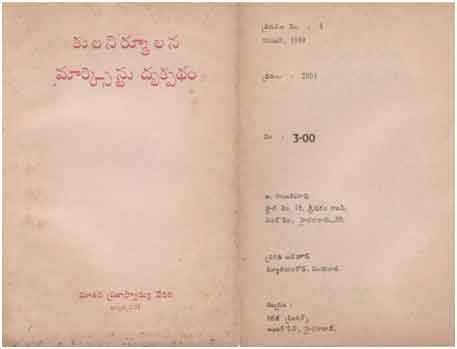
The Foreword (see picture below) mentions that the book was written to discuss caste question, not only about the communist stand, but also the ruling and election parties, and published in the context of caste riots incited by those parties in the wake of the murder of Congress Kapu leader Vangaveeti Ranga. It does not name any person.

The book was a team work , with no name mentioned as author, according to members of the team, clarified recently also. It was originally drafted by Usaa after discussions in the group that included Ilaiah and Usaa’s co-editors of Edureeta. It was later reprinted by Ilaiah with his name as the author. In fact, the team members mention that Ilaiah was then itself questioned how he could so publish his name as author, and he had no convincing answer. Now after the death of Usaa and his wife , inverting and distorting the facts, Ilaiah claims he wrote the book, and Usaa helped in it.
Is this the way a tribute is paid to a departed comrade? In what way this act can and should be described? It is left to the wisdom of the readers.
*** ***
Socio-historical context of the region and times
“In the 1960s, a barber going to school in that region was rarest of rare thing”, Ilaiah wrote. “A barber had no right to enter the temple along with Dalits”…there are assertive observations, howlers, like this in his write-up. Like these there are sentences loaded with patently false information about the Socio-historical context of the region and times.
To appreciate Usaa’s reformist life, one need not, rather should not distort the Socio-historical context of the region and times, as did Ilaiah.
Given its own historical importance and interest to any serious student of social sciences, this subject merits a brief review, but even that will occupy some space. We shall deal with it in Part-2 of this article.
*** ***
( The author is a political observer who contributed to countercurrents.org)
SIGN UP FOR COUNTERCURRENTS DAILY NEWSLETTER

